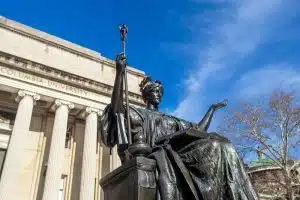Harvard vs Columbia: Which University is Right for You?
Choosing the right university can be a daunting task. With so many options available, it can be difficult to determine which one is the best fit for your needs and aspirations. That’s why we’ve created this comprehensive guide to help simplify the process for you. In this article, we’ll compare and contrast Harvard vs Columbia on various criteria such as location, admissions process, and more. By the end of this read, you’ll be able to make an informed decision about which of these prestigious institutions is the perfect match for you.
Location and Campus Comparison: Harvard vs Columbia
Location is an essential factor when considering a university. Harvard is located in Cambridge, Massachusetts, just a few miles away from Boston, one of the world’s most vibrant and dynamic cities.
Columbia, on the other hand, is situated in New York City, giving students unparalleled access to the Big Apple, a bustling metropolis that never sleeps. While both cities offer an incredible plethora of cultural and entertainment opportunities, Boston is a smaller, more intimate setting, while New York is a bustling, vibrant hub of activity.
In terms of campus comparison, both Harvard and Columbia have breathtakingly beautiful campuses, characterized by a mix of architectural styles. Harvard’s campus features a classic Ivy League look, with Old English-inspired buildings and sprawling green lawns. Columbia, on the other hand, has a more modern feel, with sleek, contemporary buildings designed by famous architects such as I. M. Pei and Renzo Piano.
Another important aspect to consider when comparing the campuses of Harvard and Columbia is the size. Harvard’s campus is spread out over 209 acres, while Columbia’s campus is much smaller, covering only 36 acres. This means that Harvard has more open spaces and green areas, while Columbia’s campus is more compact and easier to navigate.
Additionally, Harvard has a more residential feel, with most students living on campus, while Columbia has a more urban feel, with many students living off-campus in nearby apartments and neighborhoods.
Admissions Process: How to Get into Harvard vs Columbia
Getting into either Harvard or Columbia is notoriously difficult, with acceptance rates hovering around 5% or less. So, what does it take to get accepted into these prestigious universities? In general, both schools look for students who have a record of academic excellence, leadership potential, and a demonstrated passion for extracurricular activities. However, there are some differences in the application process between the two institutions.
At Harvard, applicants must complete the Common Application, which includes a personal essay, an extracurricular activities list, and two teacher recommendations. Harvard also requires SAT or ACT scores but is test-optional for the class of 2025. Additionally, the university has a unique interview process that pairs applicants with alumni for an informal chat.
Columbia’s application process is more streamlined than Harvard’s, with no supplemental essays or teacher recommendations required. However, Columbia does require the submission of SAT or ACT scores, along with either SAT subject tests or AP exam scores. Columbia also requires an additional personal essay that is centered around the university’s core curriculum.
It’s important to note that both Harvard and Columbia have holistic admissions processes, meaning that they consider a variety of factors beyond just grades and test scores. This includes factors such as personal background, life experiences, and unique talents or achievements. Both universities also offer need-blind admissions, meaning that they do not consider an applicant’s ability to pay when making admissions decisions.
Academic Offerings: What Programs and Majors are Available at Harvard and Columbia?
Both Harvard and Columbia offer an extensive range of academic programs, with departments ranging from the humanities and social sciences to the natural sciences and engineering.
At Harvard, students have access to over 90 departments and concentrations, including top-ranking programs in law, business, and medicine. Columbia, on the other hand, is known for its strong programs in the arts, journalism, and international studies, including a top-ranked graduate school of journalism.
Moreover, the two universities differ in their approach to undergraduate education. Harvard’s pedagogical methodology emphasizes the importance of a liberal arts education, giving students exposure to a wide range of disciplines before specializing in their chosen field. In contrast, Columbia’s curriculum is structured around a core program that emphasizes interdisciplinary studies and intellectual exploration.
Additionally, both universities offer a variety of research opportunities for students. Harvard has over 100 research centers and institutes, including the Harvard-Smithsonian Center for Astrophysics and the Harvard Stem Cell Institute. Columbia, on the other hand, has a strong focus on interdisciplinary research, with centers such as the Earth Institute and the Data Science Institute.
Furthermore, both universities have a strong commitment to community service and social justice. Harvard’s Phillips Brooks House Association is one of the oldest student-run organizations in the country, providing opportunities for students to engage in community service and social advocacy. Columbia’s Center for Justice is dedicated to promoting social justice through research, education, and community engagement.
Cost of Attendance: How Much Does it Cost to Attend Harvard vs Columbia?
Both Harvard and Columbia are private Ivy League institutions and, as such, come with a higher price tag than many other universities. For the 2021-2022 academic year, Harvard’s total cost of attendance, including tuition, fees, room, and board, is $78,200. Columbia’s total cost of attendance is similar, at $80,870, but can vary depending on factors such as discipline and financial need.
It is worth noting that both universities have substantial financial resources and offer generous need-based and merit-based financial aid packages to eligible students. Students should apply for financial aid at both universities to determine the best financial fit for them.
Aside from the cost of attendance, both Harvard and Columbia offer a wide range of academic programs and extracurricular activities that can enrich a student’s college experience. Harvard, for example, has a strong focus on research and offers numerous opportunities for students to engage in cutting-edge research projects. Columbia, on the other hand, has a vibrant arts scene and is home to several world-renowned arts institutions, such as the Columbia University School of the Arts and the Miller Theatre.
Furthermore, both universities have a diverse student body, with students from all over the world and from a variety of backgrounds. This diversity can provide students with a unique opportunity to learn from and engage with individuals from different cultures and perspectives, which can be invaluable in today’s globalized world.
Financial Aid and Scholarships: What Are Your Options at Harvard and Columbia?
Both Harvard and Columbia offer significant financial aid packages to help ensure that talented students from all backgrounds have access to their academic programs. Harvard, in particular, has a highly generous need-based program that covers the full demonstrable need of students each year, without any loans or work-study requirements.
Columbia’s financial aid program is more merit-based, with students who have outstanding academic or leadership records being eligible for scholarships and awards. In addition, Columbia offers a small number of full-ride scholarships to exceptionally talented students from underrepresented communities.
It is important to note that both Harvard and Columbia also offer additional resources and support for students seeking financial aid. This includes financial literacy programs, counseling services, and assistance with navigating the application process.
Additionally, both universities have partnerships with external organizations and foundations that provide additional scholarship opportunities for students. It is recommended that students thoroughly research and explore all available options to ensure they are receiving the maximum amount of financial support possible.
Campus Life: Student Activities and Social Scene at Harvard vs Columbia
The campus culture at both Harvard and Columbia is active and diverse, with a range of clubs and organizations to suit the interests of every student. Harvard has over 400 student organizations, including academic clubs, cultural groups, and sports teams. Columbia’s student life is similarly active, with over 500 student groups dedicated to a variety of causes and interests.
Both universities benefit from their metropolitan locations, with students having easy access to cultural and artistic events in the surrounding cities. Harvard Square, the area surrounding the university, is a vibrant cultural hub, with dozens of cafes, bookstores, and art galleries. At Columbia, the nearby neighborhoods of Morningside Heights and Harlem offer an unparalleled range of restaurants, bars, and music venues.
In addition to the numerous student organizations and cultural events, both Harvard and Columbia offer a variety of opportunities for students to engage in community service and social justice initiatives. Harvard’s Phillips Brooks House Association is one of the oldest student-run organizations in the country, providing students with opportunities to volunteer in the local community.
Columbia’s Center for Justice is dedicated to promoting social justice through education, research, and advocacy, and offers a range of programs and events for students interested in social justice issues.
Student-Faculty Ratio and Class Size Comparison: What to Expect at Harvard vs Columbia
Harvard and Columbia are both research universities, meaning that they prioritize faculty research alongside undergraduate education. However, both universities strive to maintain a low student-to-faculty ratio, ensuring that students have ample opportunities to work closely with faculty members and receive personalized instruction.
At Harvard, the student-to-faculty ratio is 7:1, with an average class size of 12 students. Columbia’s student-to-faculty ratio is slightly higher, at 6:1, with an average class size of 18 students. Despite these slight differences, both universities provide an exceptional academic experience with highly engaged faculty members.
It’s worth noting that while the student-to-faculty ratio and class size are important factors to consider when choosing a university, they are not the only ones. Other factors such as location, campus culture, extracurricular activities, and available resources should also be taken into account. Ultimately, the best way to determine if a university is the right fit for you is to visit the campus, talk to current students and faculty members, and get a feel for the overall atmosphere.
Athletics and Sports Programs at Harvard vs Columbia
Athletics can play an important role in campus culture and community building. Both Harvard and Columbia offer a wide range of varsity and club sports programs for students, with opportunities to compete at a high level, but neither has a particularly strong reputation or tradition in sports.
Harvard’s Ivy League affiliation means that its varsity teams compete against other top universities in the conference, including Columbia. Columbia’s sports teams are members of the Ivy League as well, and the university has notable programs in rowing and fencing.
Despite not having a strong reputation in sports, both Harvard and Columbia have produced notable athletes who have gone on to compete at the professional level. Harvard has produced several NFL players, including Ryan Fitzpatrick and Matt Birk, while Columbia has produced notable basketball players such as Jim McMillian and Chet Forte.
Both universities also offer extensive recreational sports programs for students who are not interested in varsity or club sports. These programs include fitness classes, intramural sports leagues, and outdoor adventure programs.
Study Abroad Opportunities: Where Can You Go as a Student of Harvard or Columbia?
Both Harvard and Columbia place a high emphasis on international education, with robust study abroad programs that allow students to gain firsthand exposure to different cultures and perspectives. Harvard offers over 200 study-abroad programs in more than 50 countries, while Columbia has more than 200 study-abroad programs in over 100 countries.
From studying Mandarin in Beijing to exploring art history in Florence, students at both universities have a wide range of immersive learning opportunities available to them.
In addition to traditional study abroad programs, both Harvard and Columbia offer unique opportunities for students to engage in service learning and research abroad.
For example, Harvard’s “Program in Global Surgery and Social Change” allows medical students to work with local healthcare providers in low-resource settings, while Columbia’s “Earth Institute Practicum in Sustainability Leadership” gives students the chance to work on sustainability projects in countries such as Brazil and India. These programs not only provide valuable learning experiences but also allow students to make a positive impact in communities around the world.
Research Opportunities: What Kind of Research is Conducted at Harvard and Columbia?
As mentioned earlier, both Harvard and Columbia are research universities, meaning that faculty members and students alike engage in cutting-edge research across a variety of fields.
Harvard’s research strengths lie in the sciences, engineering, and medicine, with notable research centers such as the Harvard Medical School and the Wyss Institute for Biologically Inspired Engineering. Columbia’s research strengths are in social sciences and humanities, with a particular focus on international relations, human rights, and urban studies.
Both universities have extensive resources and support for undergraduate research, including funded research opportunities and access to state-of-the-art facilities and equipment.
At Harvard, students can also participate in research through the Harvard College Research Program, which provides funding for independent research projects. Additionally, Harvard has a strong focus on interdisciplinary research, with initiatives such as the Harvard Stem Cell Institute and the Harvard Global Health Institute.
Meanwhile, Columbia has a number of research centers and institutes dedicated to specific areas of study, such as the Earth Institute and the Institute for Research in African-American Studies. The university also offers opportunities for students to participate in research abroad, through programs such as the Global Scholars Program.
Alumni Network and Connections: Benefits of Graduating from Harvard or Columbia.
Harvard and Columbia have produced some of the world’s most successful and influential graduates, ranging from Nobel laureates and business tycoons to presidents and Hollywood stars. Graduating from either institution can offer access to a vast and supportive alumni network, with opportunities to connect and network with successful alumni in a variety of fields.
Harvard’s alumni network is particularly robust and active, with more than 371,000 living graduates worldwide. The Harvard Alumni Association offers a range of events, services, and resources for alumni to stay connected and engaged with the university community.
Columbia’s alumni network is similarly extensive, with over 350,000 alumni in more than 200 countries. The university’s Office of Alumni and Development oversees a range of initiatives, including career services, mentoring programs, and alumni clubs and chapters.
Furthermore, both Harvard and Columbia have established partnerships with various companies and organizations, providing their alumni with exclusive job opportunities and career advancement resources. These partnerships also offer alumni access to specialized training programs, workshops, and conferences, allowing them to stay up-to-date with the latest industry trends and developments.
Conclusion: Which University is the Best Fit for You?
Deciding on Harvard vs Columbia ultimately depends on your individual needs and priorities. Both universities offer a world-class education with exceptional academic programs, talented and engaged faculty, and a vibrant and diverse campus culture.
Harvard’s intimate and historic setting in Cambridge may be appealing to those who value a more traditional campus experience, while Columbia’s location in the heart of New York City may be more attractive to those seeking a more urban and dynamic lifestyle.
Either way, you can’t go wrong with either Harvard or Columbia, as both offer unparalleled opportunities to learn, grow, and excel.
It’s important to consider factors beyond academics and location when making your decision. Harvard and Columbia have different campus cultures and student communities. Harvard is known for its strong emphasis on undergraduate research and its competitive social scene, while Columbia is known for its politically active student body and diverse range of student organizations.
Consider what type of community you want to be a part of and what extracurricular activities you want to pursue when making your decision.
Want to learn more about getting into your dream school? You’ve come to the right place. At AdmissionSight, we have over 10 years of experience guiding students through the competitive admissions process.
AdmissionSight can help you put your best foot forward when applying to college this fall. Contact us today for more information on our services.









































